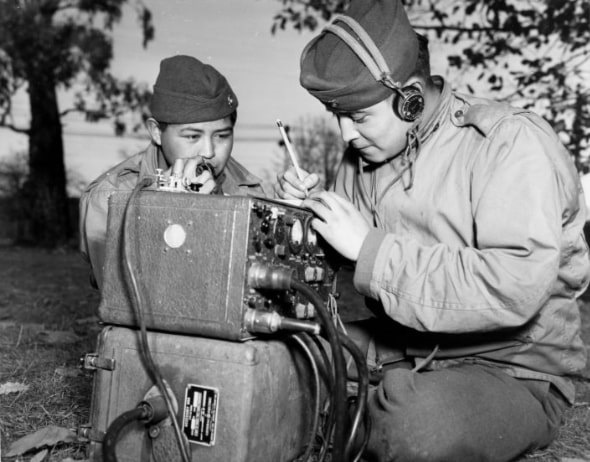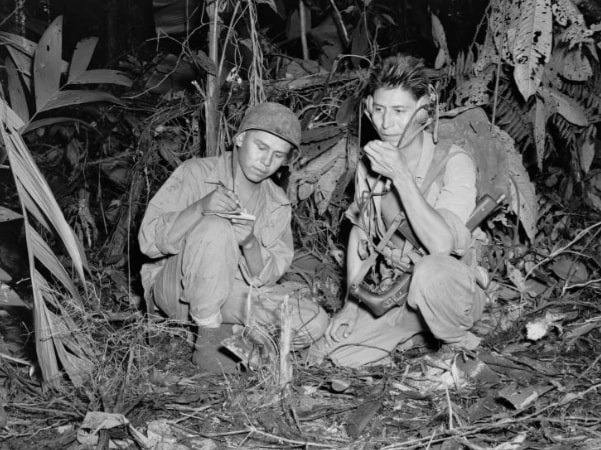Introduction: In this article, to celebrate the last day of Native American Heritage Month, Gena Philibert-Ortega writes about the Navajo Code Talkers and the key role they played in WWII. Gena is a genealogist and author of the book “From the Family Kitchen.”
Recent recognition has been made through movies and books of the people responsible for breaking World War II secret military codes. The movie The Imitation Game focused on the British team that cracked Nazi codes. Several recent books, such as Liz Munday’s Code Girls, spotlight American women who worked at code breaking. War requires secret codes to transmit plans and orders without the enemy understanding what is being discussed.
One “unbreakable” code the American military used in WWII utilized the Navajo language. The soldiers who worked on transmitting those codes were the Navajo Code Talkers.

It makes sense that the best code is one based on a language that few people speak. Enter the Navajo. This 1945 newspaper article called the Navajo language a “hidden language.”

This article reported:
“Navajo, however, is one of the world’s ‘hidden’ languages, as no alphabet or other symbols of it exists in the original form. There are only about 55,000 Navajos, all concentrated in one region, living on Government reservations and intensely clannish by nature, which has confined the tongue to its native area.
“…Except for the Navajos themselves, only a handful of Americans speak the language. At the time the Marine Corps adopted Navajo as a voice code, it was estimated that not more than 28 other persons, American scientists or missionaries who lived among the Navajos and studied the language for years, could speak Navajo fluently.”
In fact, the man who suggested the use of Navajo, Philip Johnston, was a son of a missionary who was one of the few non-Navajo who spoke the language. A World War I veteran, he knew the military had previously used the Choctaw language for secret codes and believed the Navajo language would make for an undecipherable code. (1)
However, even with the Navajo language (which was largely invisible due to a lack of written records), “Code talkers didn’t speak plain language in Navajo, but rather encoded the messages in a phonetic code and incorporated other vocabulary adaptations to meet the needs of modern warfare. Thus, anyone seeking to intercept the messages would have to know both the Navajo language and the codebook.” (2) Knowing the Navajo language wasn’t enough to break these codes, making it even more impossible to decipher these secret messages.
At War and Beyond
As of 1945, 500 Navajos were serving their country in the military, but not all of them as code talkers. However, the majority (around 375-420) were. (3) Navajo code talkers were found in the Pacific theatre, where they were instrumental in Marine operations such as the assault on Iwo Jima. (4) “At Iwo Jima, six Navajo Code Talkers transmitted more than 800 messages without error.” (5) So important was their contribution that “5th Marine Division signal officer Major Howard Connor stated, ‘Were it not for the Navajos, the Marines would never have taken Iwo Jima.’” (6)
The Navajo code program was so successful, there were ideas to continue its use. Because of this it was largely kept secret and not discussed in public. It wasn’t until 1968 that the program was declassified and information about it, including stories about the soldiers involved, became more prevalent.
Even though you can find various mentions of individual Code Talkers and the program in historical newspapers, it wasn’t until August 1982 that President Reagan proclaimed a Navajo Code Talkers Day, which later became an Arizona state holiday (August 14th, Navajo Code Talkers Day). Then in 2001 they received the recognition they deserved: a Congressional Silver Medal (those who developed the code had been awarded the Congressional Gold Medal previously). (7)
Resources
Here are some resources for learning more about the Navajo and the Navajo Code Talkers:
- You can read the Navajo code from the Navajo Code Talkers Dictionary that is available online from the Navy Department Library.
- GenealogyBank’s Native American Historical Newspaper Archives include the Navajo Times (Window Rock, Arizona).
- There are 25 photos of Navajo Code Talkers, dated 1943-1948, available online at the National Archives Catalog. A search on the Catalog for the keyword Navajo will also reveal other military and non-military records.
- The FamilySearch Research Wiki has several articles that can help you better understand Native American genealogy, including this article on the Navajo Nation.
Note: An online collection of newspapers, such as GenealogyBank’s Historical Newspaper Archives, is not only a great way to learn about the lives of your ancestors – the old newspaper articles also help you understand American history and the times your ancestors lived in, and the news they talked about and read in their local papers. Did any of your ancestors serve in WWII? Please share your stories with us in the comments section.
__________________
(1) “Navajo Code Talkers,” The Navy Department Library (https://www.history.navy.mil/research/library/online-reading-room/title-list-alphabetically/n/code-talkers.html: accessed 23 November 2021).
(2) “Navajo Code Talkers,” The Unwritten Record (https://unwritten-record.blogs.archives.gov/2020/12/01/navajo-code-talkers/: accessed 23 November 2021).
(3) “Navajo Code Talkers,” The Navy Department Library (https://www.history.navy.mil/research/library/online-reading-room/title-list-alphabetically/n/code-talkers.html: accessed 23 November 2021).
(4) “Navajo Code Talkers,” The Unwritten Record (https://unwritten-record.blogs.archives.gov/2020/12/01/navajo-code-talkers/: accessed 23 November 2021).
(5) 1942 Navajo Code Talkers,” Intel.gov (https://www.intelligence.gov/index.php/people/barrier-breakers-in-history/453-navajo-code-talkers: accessed 23 November 2021).
(6) “American Indiana Code Talkers,” National World War II Museum (https://www.nationalww2museum.org/war/articles/american-indian-code-talkers: accessed 23 November 2021).
(7) “American Indiana Code Talkers,” National World War II Museum (https://www.nationalww2museum.org/war/articles/american-indian-code-talkers: accessed 23 November 2021).
